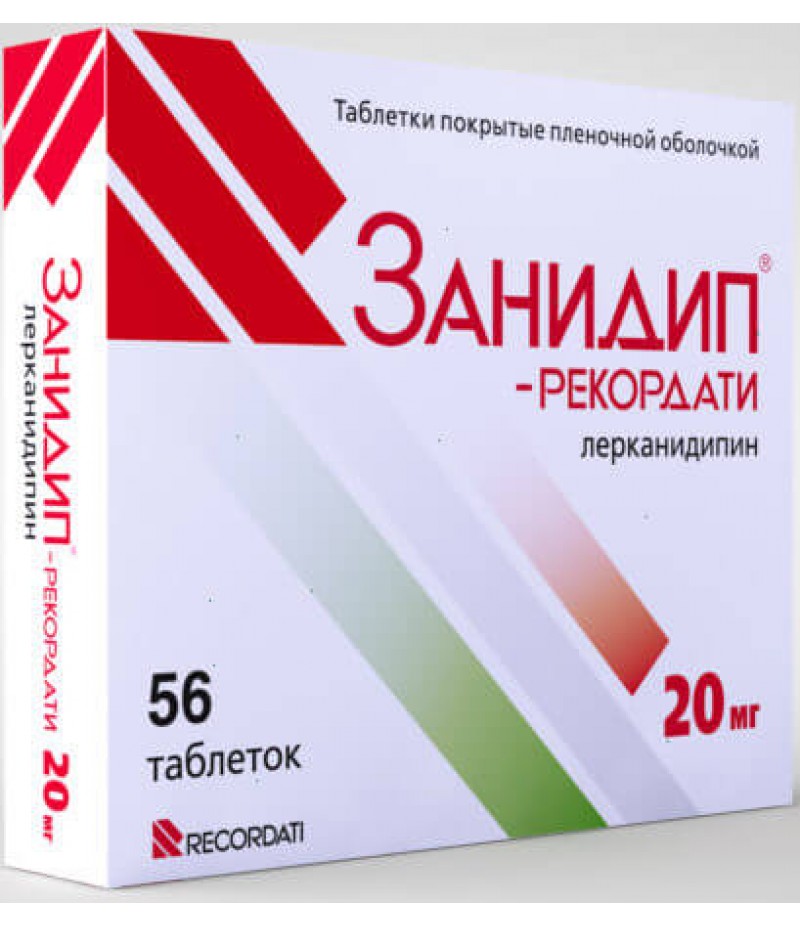Zanidip tabs 20mg #56
- $47.50
- 2 or more $46.20
- 3 or more $45.40
- Availability:In Stock
Instruction for ZanidipReed more and buy Zanidip on this pagePharmacodynamicsLercanidipine, a blocker of “slow” calcium channels, is a racemic mixture of right- (R) and levogyrate (S) stereoisomers, a derivative of 1,4-dihydropyri..
Tags: tabs
Instruction for Zanidip
Reed more and buy Zanidip on this page
Pharmacodynamics
Lercanidipine, a blocker of “slow” calcium channels, is a racemic mixture of right- (R) and levogyrate (S) stereoisomers, a derivative of 1,4-dihydropyridine, which is able to selectively block the flow of calcium ions into the cells of the vascular wall, heart cells and smooth muscle cells.
The mechanism of the hypotensive action is due to the direct relaxing effect on vascular smooth muscle cells. It has a prolonged antihypertensive effect. The therapeutic effect is achieved 5–7 hours after ingestion and its duration lasts for a day (24 hours). Due to its high selectivity for vascular smooth muscle cells, there is no negative inotropic effect. Lercanidipine is a metabolically neutral drug and does not have a significant impact on the content of lipoproteins and apolipoproteins in the serum, and does not alter the lipid profile in patients with arterial hypertension.
Pharmacokinetics
Suction. After oral administration, lercanidipine is almost completely absorbed from the gastrointestinal tract. Cmax in plasma is reached in 1.5–3 h and amounts to 3.3 and 7.66 ng / ml after taking 10 and 20 mg, respectively.
Distribution from blood plasma to tissues and organs occurs quickly. Communication with proteins of a blood plasma exceeds 98%. In patients with renal and hepatic insufficiency, the plasma protein content is reduced, so the free fraction of lercanidipine may be increased.
Metabolism. It is metabolized during the "primary passage" through the liver by biotransformation by an isoenzyme of the CYP3A4 system with the formation of a number of metabolites that do not possess pharmacological activity.
Excretion occurs by the kidneys and intestines after biotransformation. There are 2 phases of lercanidipine release: the early (T1 / 2 value is 2–5 hours) and the final one (the T1 / 2 value is 8–10 hours). Zanidip in unchanged form is practically not detected in the urine and fecal masses.
At repeated use does not accumulate.
Indications
Essential hypertension mild to moderate severity.
Contraindications for Zanidip
hypersensitivity to lercanidipine, another derivative of the dihydropyridine series, or any component of Zanidip;
chronic heart failure in the stage of decompensation;
unstable angina, vascular obstruction, emanating from the left ventricle of the heart, recent myocardial infarction (for 1 month);
severe liver dysfunction, kidney dysfunction (glomerular filtration rate less than 39 ml / min);
simultaneous use with powerful inhibitors of isoenzyme CYP3A4 (ketoconazole, itraconazole, erythromycin), as well as with grapefruit juice, cyclosporine;
pregnancy and lactation period; use in women of childbearing age who do not use reliable contraception;
children's age up to 18 years (efficiency and safety are not established);
lactase deficiency, lactose intolerance, glucose-galactose malabsorption.
With care: dysfunction of a liver of easy and moderate severity; sick sinus syndrome (without pacemaker), left ventricular failure and coronary heart disease; chronic heart failure; simultaneous reception of beta adrenoblockers, digoxin.
Use during pregnancy and lactation
The drug is contraindicated during pregnancy and during breastfeeding.
Side effects
WHO statistics: very often - 1/10 of appointments; often 1/100 of appointments; infrequently - 1/1000 appointments; rarely 1 / 10,000 appointments; very rarely - less than 1/10000 appointments.
On the part of the nervous system: rarely - drowsiness; infrequently - headache, dizziness.
On the part of the immune system: very rarely - hypersensitivity.
On the part of the cardiovascular system: infrequently - tachycardia, sensation of heartbeat; flushing of the skin of the face; rarely - angina; very rarely - fainting, marked reduction in blood pressure, chest pain, myocardial infarction.
On the part of the digestive system: rarely - nausea, vomiting, diarrhea, abdominal pain, dyspepsia; very rarely - an increase in liver enzymes (reversible).
Skin: rarely - skin rash.
On the part of the musculoskeletal system: rarely - myalgia.
From the urinary system: rarely - polyuria.
General disorders and local reactions: infrequently - peripheral edema; rarely - asthenia, fatigue; very rarely - gingival hyperplasia.
Interaction
Zanidip can not be taken simultaneously with inhibitors of CYP3A4 (liver cytochrome P450 isoenzyme), such as ketoconazole, itraconazole, erythromycin (increase the concentration of lercanidipine in the blood and lead to potentiation of the antihypertensive effect).
Concurrent use of lercanidipine with cyclosporine is contraindicated. This leads to an increase in the content of both substances in the blood plasma. Lercanidipine should not be taken together with grapefruit juice, as this leads to a depression of lercanidipine metabolism and potentiation of the antihypertensive effect.
It is necessary to be careful at simultaneous reception with such drugs as terfenadin, astemizol, quinidine and class III antiarrhythmic drugs (for example, amiodarone).
Simultaneous use with anticonvulsant drugs (for example, phenytoin, carbamazepine) and rifamycin can lead to a decrease in the level of lercanidipine in the blood plasma and, therefore, to a decrease in the antihypertensive effect of lercanidipine.
While taking digoxin, it is necessary to regularly monitor signs of digoxin intoxication.
Taking the drug with midazolam in old age leads to an increase in the absorption of lercanidipine and a decrease in the rate of absorption.
Metoprolol reduces the bioavailability of lercanidipine by 50%, while the bioavailability of metoprolol remains unchanged. This effect may occur due to a decrease in hepatic blood flow, which is caused by beta-blockers, therefore it can also manifest itself when used with other drugs in this group.
Cimetidine at a dose of 800 mg per day does not lead to significant changes in plasma concentration of lercanidipine, however, special care is required, since with higher doses of cimetidine, the bioavailability of lercanidipine, and hence its antihypertensive effect, may increase.
When used simultaneously with simvastatin, Zanidip should be taken in the morning and simvastatin in the evening.
Fluoxetine has no effect on the pharmacokinetics of lercanidipine.
Acceptance of lercanidipine simultaneously with warfarin does not affect the pharmacokinetics of the latter.
Lercanidipine can be used simultaneously with beta-blockers, diuretics, ACE inhibitors.
Ethanol may enhance the antihypertensive effect of lercanidipine.
Dosage and administration
Inside, in the morning, no less than 15 minutes before a meal, without chewing, drinking plenty of water. Zanidip is prescribed 10 mg 1 time per day. The dose can be increased up to 20 mg (in case, when taking 10 mg, the expected effect is not achieved). The therapeutic dose is adjusted gradually, increasing the dose to 20 mg is carried out 2 weeks after the start of Zanidip.
Use in elderly patients. Dose adjustment is not required, but when taking Zanidip requires constant monitoring of patients.
Use in patients with impaired renal or hepatic function. In the presence of mild to moderate renal or hepatic insufficiency, as a rule, dose adjustment is not required, the initial dose is 10 mg, and the dose should be increased to 20 mg / day with caution. If the antihypertensive effect is too pronounced, the dose should be reduced.
Overdose
Symptoms: peripheral vasodilation with a pronounced decrease in blood pressure and reflex tachycardia, an increase in the frequency and duration of strokes, myocardial infarction.
Treatment: symptomatic therapy.
special instructions
Caution should be exercised in the appointment of patients with impaired renal function, coronary artery disease (there is a risk of increased angina attacks), chronic heart failure must be compensated before starting Zanidip.
Special care should be taken at the initial stages of treatment of patients with mild and moderate severity of liver failure.
Influence on the ability to control the mechanisms and the car. During the period of treatment, care must be taken when performing work that requires increased attention when driving, especially at the beginning of treatment and when increasing the dose of the drug (risk of drowsiness, headache and dizziness).
Release form
Film-coated tablets, 10 mg, 20 mg. By 7, 14, 15, 25, 28 or 30 table. in a blister of opaque PVC film / aluminum foil. 1, 2, 3, 4, 5, 6 or 7 blisters are placed in a cardboard box.
Terms of sell
You don't need a prescription to buy Zanidip


